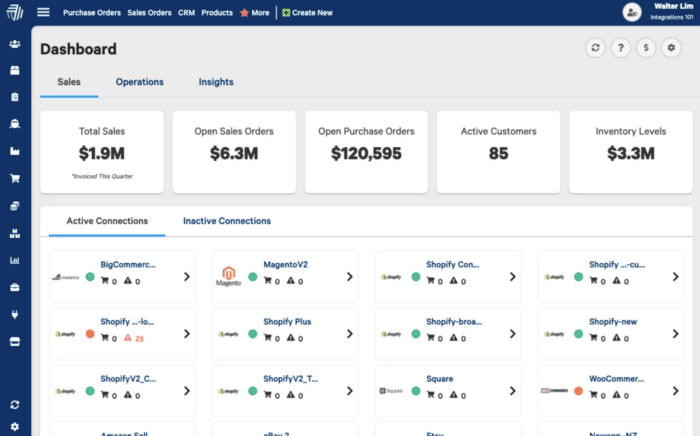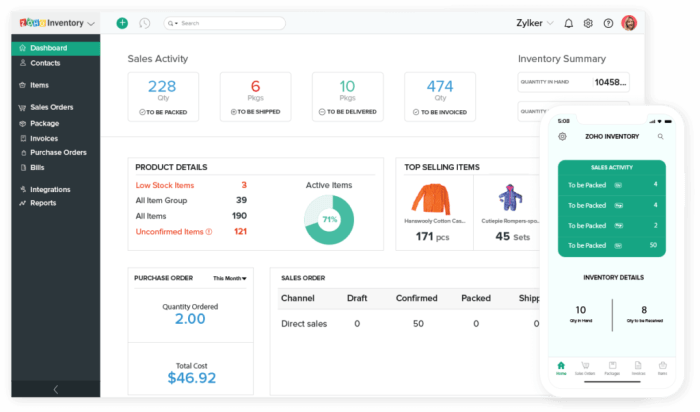Sales and inventory management software revolutionizes how businesses operate, offering a powerful blend of sales tracking, inventory control, and reporting functionalities. Efficient management of stock levels prevents costly overstocking or frustrating stockouts, directly impacting profitability. This integrated approach streamlines operations, allowing businesses to focus on strategic growth rather than tedious manual processes. The software automates many tasks, freeing up valuable time and resources for more critical aspects of the business.
Further benefits include improved forecasting accuracy, enhanced customer service through real-time inventory visibility, and better decision-making based on data-driven insights. By centralizing data and automating workflows, businesses can achieve significant improvements in efficiency, accuracy, and ultimately, their bottom line. The selection of the right software is crucial, however, as different systems cater to various business sizes and needs.

Source: mysearchintent.com
In today’s competitive business landscape, efficient management of sales and inventory is paramount to success. Manual processes are often slow, prone to errors, and lack the real-time visibility needed for informed decision-making. This is where sales and inventory management software steps in, offering a powerful solution to streamline operations and boost profitability. This detailed guide explores the key features, benefits, and considerations when choosing the right software for your business.
Understanding the Core Functionality of Sales and Inventory Management Software
Sales and inventory management software, often referred to as inventory management systems (IMS) or retail management systems (RMS), integrates various aspects of your business into a single, centralized platform. This integration eliminates data silos and provides a holistic view of your operations. Key functionalities typically include:
Inventory Tracking and Management:
- Real-time Inventory Visibility: Accurately track stock levels across multiple locations, reducing stockouts and overstocking.
- Automated Reordering: Set minimum stock levels and receive automated alerts when it’s time to reorder, preventing disruptions to sales.
- Demand Forecasting: Analyze historical sales data to predict future demand and optimize inventory levels.
- Lot and Serial Number Tracking: Manage products with unique identifiers, crucial for industries with strict regulations (e.g., pharmaceuticals, food).
- Inventory Valuation: Utilize different costing methods (FIFO, LIFO, weighted average) to accurately calculate inventory value.
Sales Management:
- Point of Sale (POS) Integration: Seamlessly process transactions, manage customer data, and generate sales reports.
- Order Management: Track orders from placement to fulfillment, improving order accuracy and reducing processing time.
- Sales Reporting and Analytics: Gain insights into sales performance, identify top-selling products, and track key metrics.
- Customer Relationship Management (CRM) Integration: Manage customer interactions, track purchase history, and personalize marketing efforts.
- Sales Forecasting: Predict future sales based on historical data and market trends.
Other Key Features:, Sales and inventory management software
- Reporting and Analytics Dashboards: Visualize key performance indicators (KPIs) to monitor progress and identify areas for improvement.
- Barcode and RFID Integration: Improve inventory accuracy and speed up the checkout process.
- Multi-location Management: Manage inventory and sales across multiple stores or warehouses.
- User Roles and Permissions: Control access to sensitive data and ensure data security.
- Integration with other Business Systems: Connect with accounting software, e-commerce platforms, and shipping providers.
Benefits of Implementing Sales and Inventory Management Software
Investing in sales and inventory management software offers numerous benefits, including:
- Reduced Inventory Costs: Optimize stock levels, minimizing storage costs and reducing waste from obsolescence.
- Improved Accuracy: Minimize errors in inventory counting and order processing, leading to greater efficiency.
- Increased Sales: Streamlined operations and better inventory management contribute to improved customer satisfaction and increased sales.
- Enhanced Decision-Making: Real-time data and analytics provide valuable insights for informed decision-making.
- Better Customer Service: Faster order processing and improved stock availability lead to enhanced customer satisfaction.
- Increased Profitability: Reduced costs, improved efficiency, and increased sales contribute to higher profitability.
- Improved Cash Flow: Efficient inventory management helps optimize working capital and improve cash flow.
- Scalability: The software can grow with your business, adapting to changing needs and increasing volume.
Choosing the Right Sales and Inventory Management Software
Selecting the right software depends on your specific business needs and budget. Consider the following factors:
- Business Size and Complexity: Choose software that scales with your business growth.
- Industry-Specific Requirements: Ensure the software meets the specific needs of your industry (e.g., serial number tracking for pharmaceuticals).
- Integration Capabilities: Check for compatibility with your existing systems (e.g., accounting software, e-commerce platform).
- User-Friendliness: Opt for intuitive software that is easy to learn and use by your team.
- Cost and Pricing Model: Compare pricing plans and choose a model that fits your budget (e.g., subscription-based, one-time purchase).
- Customer Support: Ensure the vendor provides reliable customer support and training.
- Scalability and Flexibility: The software should be able to adapt to your business’s evolving needs.
- Security and Data Protection: Prioritize software with robust security features to protect your sensitive data.
Frequently Asked Questions (FAQs)
- Q: What is the difference between sales and inventory management software and ERP software?
A: While both manage business processes, ERP (Enterprise Resource Planning) software is a broader system encompassing various departments (finance, HR, manufacturing, etc.), whereas sales and inventory management software focuses specifically on sales and inventory functions. - Q: How much does sales and inventory management software cost?
A: Costs vary widely depending on features, scalability, and vendor. Expect a range from affordable cloud-based solutions to more expensive on-premise systems. - Q: Can I integrate my existing accounting software with sales and inventory management software?
A: Many software solutions offer integration capabilities with popular accounting software packages. Check for compatibility before purchasing. - Q: How long does it take to implement sales and inventory management software?
A: Implementation time varies depending on the complexity of your business and the software’s features. Expect a timeframe ranging from a few weeks to several months. - Q: What are the key performance indicators (KPIs) to track with sales and inventory management software?
A: Key KPIs include inventory turnover rate, gross profit margin, sales growth, customer acquisition cost, and order fulfillment time.
Conclusion
Implementing sales and inventory management software is a strategic investment that can significantly improve your business’s efficiency, profitability, and competitiveness. By carefully considering your specific needs and choosing the right software, you can streamline operations, gain valuable insights, and achieve sustainable growth. Don’t hesitate to explore different options and request demos to find the perfect fit for your business.
References
- Investopedia: Inventory Management Software
- Gartner: Supply Chain Management
- Oracle: Inventory Management
Call to Action
Ready to transform your business operations? Contact us today for a free consultation and discover how the right sales and inventory management software can help you achieve your business goals.
In conclusion, implementing sales and inventory management software presents a strategic advantage for businesses of all sizes. From optimizing stock levels and enhancing forecasting to improving customer service and streamlining operations, the benefits are numerous and impactful. By leveraging the power of technology, businesses can achieve greater efficiency, accuracy, and profitability, ultimately securing a competitive edge in today’s dynamic market.
Careful consideration of specific business needs is key to selecting the most suitable software solution.

Source: clickup.com
Clarifying Questions
What are the key features to look for in sales and inventory management software?
Key features include real-time inventory tracking, sales order management, reporting and analytics dashboards, integration with accounting software, and robust security features.
How much does sales and inventory management software typically cost?
Pricing varies greatly depending on features, scalability, and vendor. Expect a range from subscription-based models with monthly fees to one-time purchases with higher upfront costs.
What type of training is typically required to use this software?

Source: selecthub.com
Most vendors provide training resources, ranging from online tutorials and documentation to in-person or virtual workshops. The complexity of training depends on the software’s features and the user’s technical proficiency.
Can sales and inventory management software integrate with my existing systems?
Many systems offer integrations with accounting, e-commerce, and other business applications. It’s crucial to check compatibility with your existing infrastructure before purchasing.